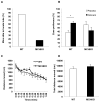Ablation of the hypothalamic neuropeptide melanin concentrating hormone is associated with behavioral abnormalities that reflect impaired olfactory integration
- PMID: 21669232
- PMCID: PMC4862865
- DOI: 10.1016/j.bbr.2011.05.039
Ablation of the hypothalamic neuropeptide melanin concentrating hormone is associated with behavioral abnormalities that reflect impaired olfactory integration
Abstract
Melanin-concentrating hormone (MCH) is an orexigenic hypothalamic neuropeptide. At least one receptor, MCH receptor 1 (MCHR1), is present in all mammals and is expressed widely throughout the brain, including cortex, striatum and structures implicated in the integration of olfactory cues such as the piriform cortex and olfactory bulb. Consistent with a potential role for MCH in mediating olfactory function, MCH knockout mice demonstrate abnormal olfactory behaviors. These behaviors include impaired food seeking by both genders in the context of normal levels of exploratory behavior, suggesting impaired olfaction. Males also exhibit increased aggression while females show defects in several olfactory mediated behaviors including mating, estrous cycle synchronization and maternal behavior. These findings suggest that hypothalamic inputs through MCH play an important role in regulating sensory integration from olfactory pathways.
Copyright © 2011. Published by Elsevier B.V.
Figures




References
-
- Bean NJ, Wysocki CJ. Vomeronasal organ removal and female mouse aggression: the role of experience. Physiol Behav. 1989;45:875–882. - PubMed
-
- Byrnes EM, Rigero BA, Bridges RS. Dopamine antagonists during parturition disrupt maternal care and the retention of maternal behavior in rats. Pharmacol Biochem Behav. 2002;73:869–875. - PubMed
-
- Duncan EA, Proulx K, Woods SC. Central administration of melanin-concentrating hormone increases alcohol and sucrose/quinine intake in rats. Alcohol Clin Exp Res. 2005;29:958–964. - PubMed
-
- Elias CF, Bittencourt JC. Study of the origins of melanin-concentrating hormone and neuropeptide EI immunoreactive projections to the periaqueductal gray matter. Brain Res. 1997;755:255–271. - PubMed
Publication types
MeSH terms
Substances
Grants and funding
LinkOut - more resources
Full Text Sources
Medical
Molecular Biology Databases

